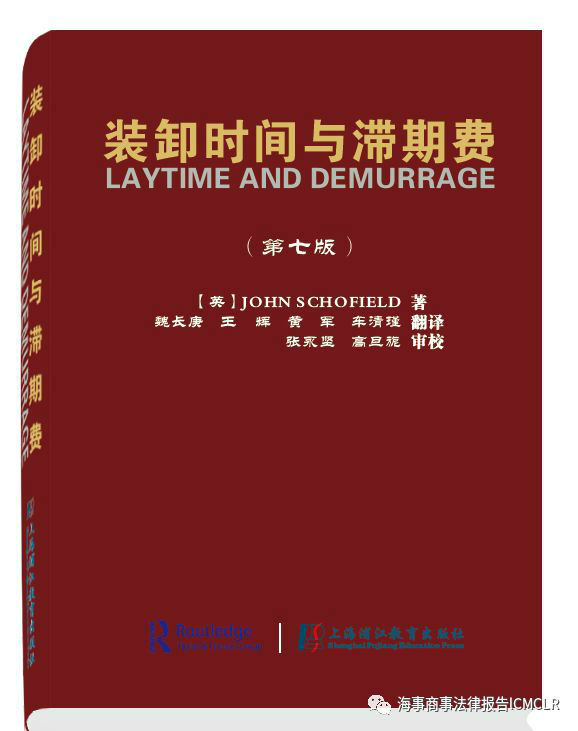魏长庚船长简介:1996-2000 年在大连海事大学学习,获得航海技术专业学士学位。具有16年海上船舶航行经验,魏长庚船长一直热爱海商法(重点是英国海商法)的学习,并致力海商法的翻译工作(包括Informa出版的Bill of Lading(提单),Laytime and Demurrage(装卸时间与滞期费)等书籍。
1《装卸时间与滞期费》第6版General Principles基本原则
1.5 It is perhaps important to remember that whilst judges, and increasingly arbitrators, lay down the interpretation to be given to particular clauses, these are often drafted by commercial men and the interpretation they are given in practice only rarely reaches arbitration, and still more rarely the higher courts.
1.5也许要着重牢记的是,法官和日益增多的仲裁员对商业人士经常拟定的特定条款已经给予了解释并使其确定下来,他们所给予的这些解释在实际中很少会提交仲裁,甚至更少会到达更高一级的法院。
1.6 Recent changes in arbitral law and practice have meant fewer appeals and this has reinforced the importance of publishing some arbitration awards of general importance in a form where the identity of the parties is not disclosed and the confidentiality of the award is preserved. Lloyd’s Maritime Law Newsletter is now the accepted forum for this type of limited publication and many of the awards reported in it are quoted in this book.
1.6 在仲裁法律和实践中,最近发生的变化是意味着更少的上诉机会,这加强了出版一些具有普遍重要意义的仲裁裁决书的重要性,同时不泄露当事人的身份和保护裁决书的机密性。《劳氏海事法律资讯》现在成为一个公认的限量出版该类型裁决书的论坛和其中很多报道的裁决书被引用在本书之内。

1.7 An indication of the number of reported cases there have been over the years is given by the length of the Table of Cases.
1.7多年以来,通过在案例一览表范围内显示给出所报道的案例编码。
1.8 There have been three attempts to introduce standardised laytime and demurrage clause definitions: the Charterparty Laytime Definitions 1980, the Voyage Charterparty Laytime Interpretation Rules 1993 and the Baltic Code 2007. These are each reproduced in full in the Appendix to this book. Each definition is, in addition, dealt with under the relevant chapter heading. These definitions will, however, apply only where they are specifically incorporated into the relevant charterparty, although they are often quoted as being persuasive of the meaning of the term in question.
1.8在此,已经有三次尝试努力引入标准化的装卸时间和滞期费条款的定义:《1980年租船合同装卸时间定义》,《1993年程租合同装卸时间解释规则》和《2007年波罗的海规则》。他们每一种形式都再次全文刊登在本书附录之内。此外,在相关的章节标题下还对每一个定义进行分析讨论。这些定义,虽然它们经常被引用作为是有说服力的有关术语的含义,然而,仅当它们被特定并入到相关的租船合同之内,才可以适用。
1.9 This first chapter is intended to set the scene on laytime and demurrage. It deals with the general principles involved and is intended to present an overview of the subject for anyone who is not familiar with it. All the topics covered in this first chapter are dealt with in greater detail elsewhere in the book.
1.9本书第一章节目的是给装卸时间和滞期费的设定一个讨论的背景。它处理有关涉及的一般基本原则,并且意图给任何对此不熟悉的人士展现该主题的大略概貌。在本书第1章包括所有的命题都将在本书其他地方作进行更加详细地论述。
1.10 It is important, before considering the principles of laytime, to see how laytime fits into the scheme of a voyage charter. The words ‘‘laytime’’ and ‘‘demurrage’’ are themselves defined in the following terms in the Voylayrules 1993.
"LAYTIME" shall mean the period of time agreed between the parties during which the owner will make and keep the vessel available for loading or discharging without payment additional to the freight.
"DEMURRAGE" shall mean an agreed amount payable to the owner in respect of delay to the vessel beyond the laytime, for which the owner is not responsible. Demurrage shall not be subject to laytime exceptions.
Laytime is probably a shortened version of lying alongside time.
1.10在讨论装卸时间原则之前,重要的是看装卸时间是如何适用在程租合同框架体系之内的。在《1993年程租合同装卸时间解释规则》中,‘装卸时间’和‘滞期费’这两个单词本身是用下列术语来定义的:
‘装卸时间’是指双方当事人共同约定的期间,在该期限内,船东使船舶和保持船舶能够进行装货或卸货而不收取额外的运费。
‘滞期费’是指装卸时间届满后,因船东不负责的原因导致的船舶延迟,就此延迟而向船东支付的约定金额。装卸时间的除外免责规定不应该适用于滞期费。
装卸时间很可能是船舶停靠时间的缩写版形式。
1.11 In The Johanna Oldendorff, Lord Diplock divided the adventure contemplated by a voyage charter into four successive stages. These are:
(1) The loading or approach voyage, viz. the voyage of the vessel from wherever she is at the date of the charterparty or the conclusion of her previous fixture, if that is later, to the place specified as the place of loading.
(2) The loading operation, viz. the delivery of the cargo to the vessel at the place of loading and its stowage on board.
(3) The carrying or loaded voyage, viz. the voyage of the vessel from the place of loading to the place specified in the charter as the place of delivery.
(4) The discharging operation, viz. the delivery of the cargo from the vessel at the place of delivery and its receipt there by the charterer or other consignee.

1.11 在The Johanna Oldendorff案例中,Diplock勋爵把根据程租合同所要从事的航程划分为四个连续的阶段。这些即是:
(1)装货或预备航程,即船舶于租船合同规定之日或前一租船合同结束之日,如后者较迟的话,从其当时所在的地方驶往所指定的装货地点的航程
(2)装货作业,即在装货地点将货物交到船上并在船上积载堆装。
(3)运送或载运航程,即船舶从装货地点到租船合同所指定的交货地点的航程
(4)卸货作业,即在交货地点由船舶交付货物,并由承租人或其他收货人在此地接受该批货物。
1.12 Although of late there have been increasing attempts to blur the distinction between the stages, Lord Diplock’s speech is clear authority that under English law the stages are consecutive and each must be completed before the next can begin. As will be seen, that means, for instance, that a vessel must reach its specified destination before a notice of readiness can be presented and notice cannot therefore be given whilst underway. There cannot be any gap between the stages, nor is there any overlap.
1.12尽管后来这里存在日益增多的尝试去混淆这些阶段之间的差异,在英国法下,Diplock勋爵的发言还是有明确的权威,这些阶段是连续的,并且每一个阶段必须在下一个开始之前完成结束。正如所看到的,它意味着,例如,在准备就绪通知书能够呈交之前,船舶必须到达其指定的目的地,因而,船舶还在航行中,是不可能给出通知书的。它们之间既不可能有任何间断,也不可能存在任何交叉重叠。

《装卸时间与滞期费》购买链接(点击蓝色字可购买)
海运圈聚焦专栏作者 魏长庚船长(微信号CaptWei)

 2018-03-06
2018-03-06 3175
3175 












